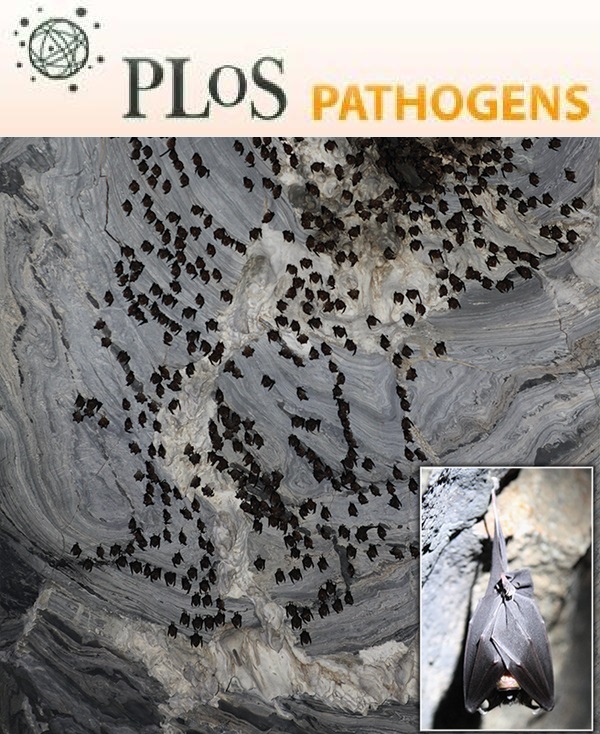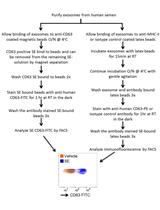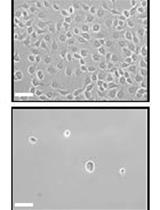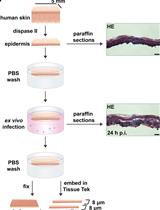- EN - English
- CN - 中文
An ex vivo Model of HIV-1 Infection in Human Lymphoid Tissue and Cervico-vaginal Tissue
HIV-1感染人淋巴组织和子宫颈阴道组织的体外模型
发布: 2014年02月20日第4卷第4期 DOI: 10.21769/BioProtoc.1047 浏览次数: 15488
评审: Anonymous reviewer(s)
Abstract
Human tissue explants are a valuable tool to study the interactions between host and infectious agents. They reliably mimic many important aspects of tissue cytoarchitecture and functions and allow us the investigation of the mechanisms of microbial pathogenesis under controlled laboratory conditions. One of the advantages of this system is that, unlike isolated cells, infection of tissue blocks with HIV-1 does not require exogenous stimulation with mitogens or activating factors. Here we describe a protocol to infect with HIV-1 human lymphoid tissue from tonsils and cervico-vaginal tissue and maintain them in culture in a non-polarized setting. These ex vivo infected tissues can be used as fruitful models to study HIV-1 pathogenesis and HIV-1 vaginal transmission, respectively, as well as an efficient platform for testing anti-HIV therapeutic and preventative strategies.
Materials and Reagents
- Tonsillar tissue obtained from routine tonsillectomy (Age range of patients: 2-10)
- Cervico-vaginal tissue obtained from routine hysterectomy (Age range of patients: 35-55)
- Gelfoam 12-7 mm adsorbable gelatin sponge (Pfizer, NDC: 0009-0315-08 )
- RPMI 1640 (Life Technologies, Gibco®, catalog number: 31870-025 )
- 100x Modified Eagle's medium (MEM)-nonessential amino acids (10 mM) (Life Technologies, Gibco®, catalog number: 11140-035 )
- 100x MEM sodium-pyruvate (100 mM) (Life Technologies, Gibco®, catalog number: 11360-070 )
- 1,000x Gentamicin (50 mg/ml) (Corning, cellgro®, catalog number: 30-005-CR )
- 100x Fungizone (250 μg/ml, amphotericin B) (Life Technologies, Gibco®, catalog number: 15290-018 )
- Fetal bovine serum (FBS) (Gemini Bio-products, catalog number: 100-106 )
Note: We advise testing several lots of serum for culture optimization and use the same lot of FBS for an entire series of experiments. We always test several serum lots on tissues from several donors and select the lot that gives the highest HIV-1 replication. Also, FBS can affect the ability of tissue to secrete cytokines in culture medium. - Phosphate Buffered Saline (PBS) (pH 7.4) (Life Technologies, Gibco®, catalog number: 10010-023 )
- Sterile water, cell culture grade (Quality Biological, catalog number: 118-162-101 )
- HIV-1 viral preparation(s)
Note: For most of our experiments we use the following viral preparations: HIV-1BaL and HIV-1LAI.04 obtained from the Virology Quality Assurance Laboratory at Rush University (Chicago, IL). Viral stocks were obtained from the clarified culture medium of peripheral blood mononuclear cell cultures inoculated with either HIV-1BaL or HIV-1LAI.04, originally received from the NIH AIDS Reagent Program. HIV-1 p24gag concentrations were 49 ± 3 ng/ml and 53 ± 3 ng/ml for HIV-1BaL and HIV-1LAI.04 stock, respectively. For more viral preparations used in our experimental setting see Introini et al., 2013 and Vanpouille et al., 2012. - Timentin (GlaxoSmithKline, NDC: 0029-6571-26 ) (see Recipes)
Note: Timentin is the commercial name of a mix of the antibiotics ticarcillin and clavulanate that are commercially available as individual reagents. These antibiotics efficiently prevent growth of bacteria that can occasionally contaminate tissue samples after surgery. Penicillin and streptomycin can be used instead of Timentin, although they have different properties. For example, Timentin displays low stability at room temperature or 37 °C (about 24 h) therefore, once added to culture medium, it remains active only for the first day of culture. - Culture medium (CM) (see Recipes)
Equipment
- Petri dish (100 mm x 20 mm) (BD, Falcon®, catalog number: 353003 )
- Petri dish (150 mm x 25 mm) (BD, Falcon®, catalog number: 353025 )
- 6-well plates (Corning, Costar®, catalog number: 3506 )
- 12-well plates (Corning, Costar®, catalog number: 3513 )
- 5, 10-ml pipettes (BD, Falcon®)
- Sealed screw-cap 1.5/2-ml tubes (SARSTEDT AG)
- Thermomixer with block for 1.5 ml-tubes (Eppendorf)
- Forceps or tweezers
- Scalpels and blades nos. 10 and 23
- Scissors
- Flat weighing metallic spatula
- 37 °C, 5% CO2 incubator set at 90% humidity
- Water bath
- 10, 50-ml syringe plunger
Procedure
文章信息
版权信息
© 2014 The Authors; exclusive licensee Bio-protocol LLC.
如何引用
Readers should cite both the Bio-protocol article and the original research article where this protocol was used:
- Introini, A., Vanpouille, C., Grivel, J. C. and Margolis, L. (2014). An ex vivo Model of HIV-1 Infection in Human Lymphoid Tissue and Cervico-vaginal Tissue. Bio-protocol 4(4): e1047. DOI: 10.21769/BioProtoc.1047.
- Introini, A., Vanpouille, C., Lisco, A., Grivel, J. C. and Margolis, L. (2013). Interleukin-7 facilitates HIV-1 transmission to cervico-vaginal tissue ex vivo. PLoS Pathog 9(2): e1003148.
分类
微生物学 > 微生物-宿主相互作用 > 离体模型
免疫学 > 宿主防御 > 人
您对这篇实验方法有问题吗?
在此处发布您的问题,我们将邀请本文作者来回答。同时,我们会将您的问题发布到Bio-protocol Exchange,以便寻求社区成员的帮助。
提问指南
+ 问题描述
写下详细的问题描述,包括所有有助于他人回答您问题的信息(例如实验过程、条件和相关图像等)。
Share
Bluesky
X
Copy link














